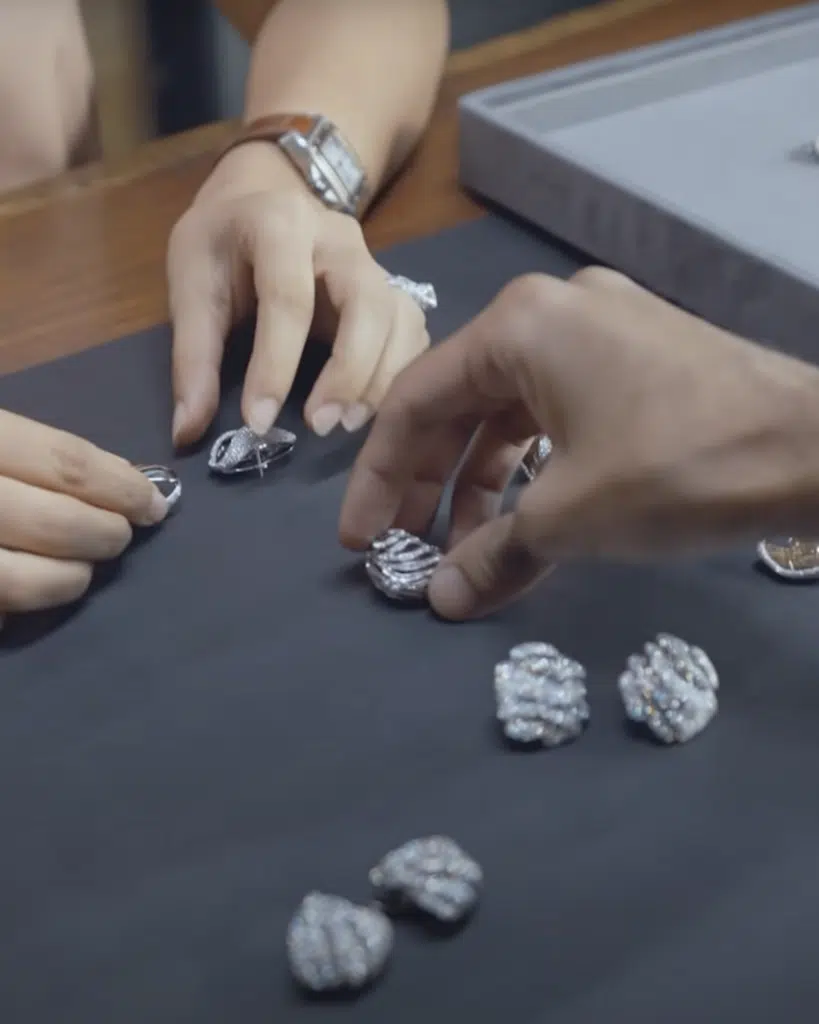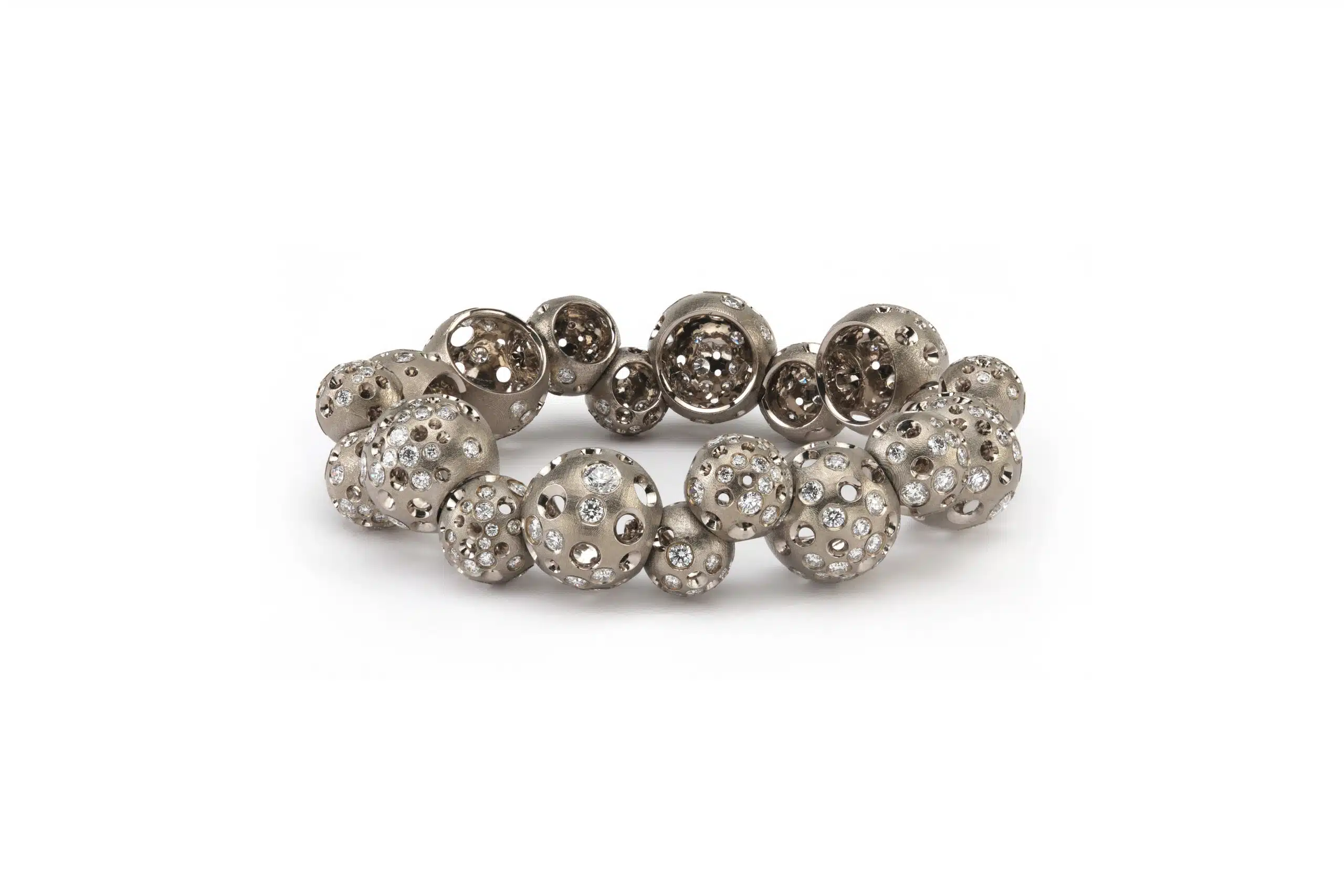Studio Renn’s thoughtful and evocative jewellery has struck a chord with the design and art world. Founded in 2018 by Roshni and Rahul Jhaveri, partners and parents who met as students at Carnegie Mellon University in the US more than two decades ago — “at International Student orientation over mango sorbet” — Studio Renn has grown rapidly, showing at the most sought after galleries and boutiques globally. Self-expression and intellect remains at the core of the Studio’s work, foregoing the conventional perfectly cut diamond in favour of the expressive and imperfect. Here, we sit down with Creative Director, Rahul Jhaveri to dive into his creative process, learn about the stories behind Studio Renn’s statement pieces, and discover how the timeless diamond can be reinterpreted.
What draws you to the diamond as a medium of expression?
My father was a diamond manufacturer, and so was his father before him. That is what I did as well before I started the Studio. Over time, diamonds became a strong part of my identity and my history. It is what ties me to the people who came before me. And whenever I use diamonds, it is an homage to where I come from. Which is why I am drawn to antique cuts, rough diamonds, freeform diamonds – they are truly unique and special. They aren’t perfect, nothing really is, but they have character.
Your practice uniquely straddles the worlds of art and fine jewellery. One of your collections, [Prime]al, was born of a poem. Can you talk us through your creative process?
Our creative process is very fluid and instinctive. We allow the work to guide us through it, and we seldom know how things are going to end up when we start. We express ourselves in whatever medium that best shows what we have to say – at times it comes out as a scribble, a phrase, a color, and at times – as poetry. For me, poetry is how you express something that cannot be expressed in any other way. When I sat down to verbalize what I internalised through my study of indigenous artforms – it came out as poetry – as Eyes Open. And that is how [Prime]al was born.


For Studio Renn, jewellery is a medium of expression, as in the Strangler Ring, an acid-treated concrete ring, inspired by the parasitic Strangler trees found in the Pench National Park, Madhya Pradesh. Courtesy of Studio Renn
Name three of your earliest inspirations.
The first is Bombay [Mumbai]. The presence and absence of nature in the city moulds us, but compels us to leave it. Second in our list would be artists from The J.J. School of Art in Bombay like Nilesh Kinkale, Prashant Salvi and Sadanand Shirke. Finally, Alexander McQueen inspires us for who he was, how he was, what he did, and why.
Acid-treated concrete isn’t the first choice of material one thinks of when it comes to jewellery. Talk us through the challenges of such experimentation. What inspired the Strangler Ring?
The Strangler Ring was a reaction to our city, Bombay, that is made of concrete. Using gold and diamonds with concrete is also an exploration of value, both perceived and assigned. And there is an ironic transient nature to concrete — our foundations are built with it but they will not last a lifetime. Conceptualising the work is always the most challenging part, and its realisation only happens through sheer stubbornness. Nitin at Material Immaterial Studio has been seminal through this exploration.
Nowhere else are the ideals of beauty in imperfection captured more fully than perhaps the Puffball pieces. But if something’s imperfect, how do you know when it’s done? How do you know to stop and leave it as-is?
With Puffball Void, we followed a process of subtraction. We filled all the voids and kept removing diamonds till the work felt balanced. It was instinctive. There is a certain amount of randomness involved, and for us, as observers, reacting to it and deciding to stop at a certain point. Serendipity plays its part.

Studio Renn, Puffball Void Sphere Bracelet. 18k Grey Gold set with round diamonds. Courtesy of Studio Renn
How do you keep your creative instincts fresh?
Curiosity is key. One must allow oneself to see things afresh, to have new and different experiences and conversations. And not to take any thought for granted but to ruminate on it. Just soak it all up – there is plenty to go around.
Which designer, living or dead, would you invite to dinner? What would you feed them?
Alexander McQueen – ghar ka khana.
Renn means ‘rebirth’. If the Studio were to be reborn today, what is one thing you would change? What would you keep the same?
Nothing and Nothing. While I wouldn’t change a single thing, things would never be the same – we aren’t the same and neither is anything else. While I wouldn’t want anything to change, I accept that nothing would ever be the same.
Where do you see your work going next?
In our manifesto that I wrote in 2018, I wrote “Where do I see Renn going? I don’t want to have a clue. I just want to be able to continue to do what I love doing – to create a world around me that represents the world hidden inside me – one which I inhabit.” It holds as true now as it did then, and I see that it will continue to stay true in the future as well.
Studio Renn was established in 2018 in Mumbai, India. Their work will be part of India Art Fair’s inaugural Design section at the 2024 edition, along with other pioneers in the field.


